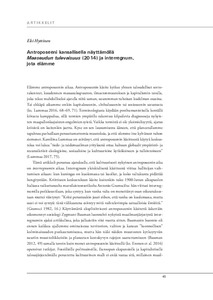Antroposeeni kansallisella näyttämöllä Maaseudun tulevaisuus (2014) ja interregnum, jota elämme
Elsi Hyttinen
https://urn.fi/URN:NBN:fi-fe2021042826241
Tiivistelmä
Anthropocene on the National Stage: Maaseudun tulevaisuus (“Future of the Countryside”, The Finnish National Theatre 2014) and the Interregnum We Live in
The article argues that entering the Anthropocene has pushed us into a cultural interregnum. However, the discussions of the Anthropocene and the concept of interregnum seldom meet. In this article it is assumed that this stems from the fact that the concept of interregnum pertains to the 20th century critical epistème and as such, it is a mismatch with the current theoretical impulse of turning toward affects, ontology and becoming. However, the case is made that we should not let go of the critical legacy altogether: to analyse struggle over and between epistemologies, we need critical concepts.
Research material in the article consists of the manuscript of Leea Klemola’s 2014 Finnish National theatre production “The Future of the Countryside”, and nine articles from the newspaper Helsingin Sanomat’s digital archive, published during the play’s opening week.
“The Future of the Countryside” asks what could the relationship between humans and their companion species be like, were it not based on the idea that it is legitimate for humans to treat the rest of the world as resources. However, the media brouhaha surrounding the play’s opening night hardly touches upon this theme at all. Instead, the nation and the limits of national culture are repeatedly evoked as the primary explanatory framework.
In this way, the “Future of the Countryside” provides an illustrative case of the interregnum we live in, understood as old epistemologies losing ground but still keeping the new from emerging.
Kokoelmat
- Rinnakkaistallenteet [19218]
